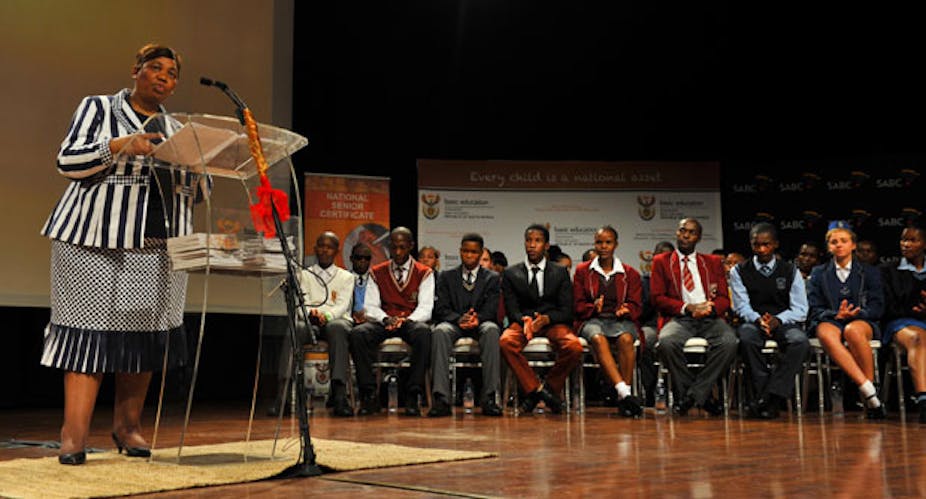In South Africa, as in many countries, the release of senior secondary school exam results, referred to locally as “the Matric”, causes a media furore every year. At 18-years-old, students either pass or fail and their results are published in early January in the newspapers by the government.
In 1996 the pass rate was 46%, rising to 78.2% in 2013. The percentage refers to how many of those who enrolled for the examinations passed at least five of their six chosen subjects. (Students can attain a National Senior Certificate with three subjects at 30% if they have the other three at 40%; the specifics have changed somewhat over the years).
The rapid rise has led to concerns about falling standards – linked to the high pass rate, the low marks required to pass and the fact that the results are subjected to statistical moderation. Others have argued that the system is failing to prepare students for higher education and the job market.
The problem is not that we have exams. Strong national curricula accompanied by rigorous national exams play a major role in building educational equality and supporting the universalising potential of education. But having a single metric for measuring the health of the education system distracts attention and distorts policy interventions, as I have argued in a recent paper.
Instead, South Africa should do away with the pass mark, and issue learners a certificate containing simply a list of their grades, without the notion of passing or failing – a system already used in Kenya.
The role of exams
Some suggest that senior secondary school should be completely separated from university entrance, as is done in the US. But not having a single set of examinations may have negative affects on educational quality and equality, with dramatically divergent standards. This type of standardised assessment, separated from prescribed curricula, tends to lead to many negative consequences such as very narrow teaching.
We want our children to learn important bodies of knowledge – and improving how this is assessed can improve how it is taught. But senior secondary schooling has to serve a range of purposes. Most countries around the world are grappling with increased youth unemployment, while education levels are substantially outpacing the educational requirements of much work.
There is pressure in many countries to make school curricula more academic, as more and more learners want, or feel obliged, to go to higher education. But at the same time school curricula are increasingly expected to mimic or reproduce the world of work.
Vocational vs academic tracks
A common justification for increasing the vocational content of the school curriculum is that in the past many children would not have been at school. These children, it is argued, cannot cope with the academic curriculum of a general liberal education, or have no interest in it, but could gain useful skills through school.
In South Africa, large numbers of our children enroll for semi-vocational subjects – business studies is taken by about 40% of secondary school students and tourism by 20% – that are not teaching them either robust academic skills by building concepts and knowledge, nor preparing them for work in any meaningful way.
Many European countries, such as Germany, have a limited set of strong but different qualifications, one of which prepares learners for academia – and one or two others that are more vocationally oriented. This generally works for universities as it supports a strong academic track for students. Where there are substantial good career options for mid-level occupations – and where companies offer apprenticeships – this is a viable option for all learners, although it has the disadvantage of funnelling people at a young age.
But quality vocational education is almost impossible to achieve in the absence of quality jobs in defined occupations. Despite the outcry about a lack of skills in the South African economy, research on industrialising and developing states shows that skills and education generally follow economic development – it has not happened the other way round.
Where good mid-level jobs are not available, vocational education is often low status. Most people choose academic education, which is weakened by, amongst other factors, weak semi-vocational education. We need to rethink the value of such vocational subjects, in a broader debate about the purpose of senior secondary school.
Improving English
Another national priority is strengthening South Africa’s curriculum and exam for English as a first additional language, given that other subjects are learnt through English. In 2013, just over 500 000 learners were entered for the matriculation examination, and 454 666 of them wrote English First Additional Language. Recent research from Umalusi suggests serious problems with the curriculum, including that it does not prepare learners well for university study. It found that the English course is broad and shallow, with too many texts but not enough long texts, and that there is little progression across the years, and no time for remediation.
A simple change such as removing the notion of pass or fail from the Matric could allow for a more intelligent conversation and more focused education reform in order to substantially improve the performance of the system, and end the futile “pass rate” debate.

